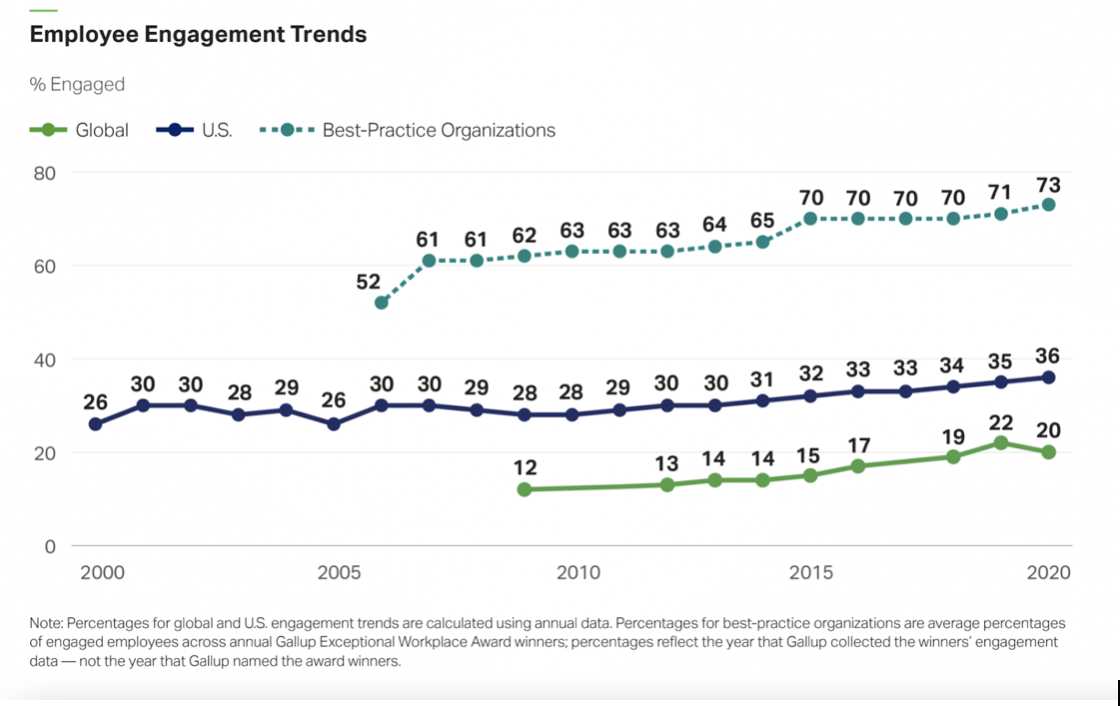
Having just caught our breath from working through the COVID crisis, business leaders find themselves with a whole new challenge: Keeping their people engaged so that they are productive and loving their job.
According to 2021 reports from Gallup People Management, almost half of employees have considered a change in careers within the past 12 months and a shocking four million people left their jobs in April of this year.
The ‘Great Resignation’ is thought to have stemmed from the events of the past two years where millions of employees have been working remotely due to lockdown restrictions. People have gotten used to the added freedom of working from home, and they are unwilling to let this go and return to office-based work. Globally, employee engagement dropped by 2% in 2020 compared to the year before. They also reported higher worry, stress, and sadness.
How Engaged Are You Employees?
Employee engagement is an accurate reflection of how enthusiastic and motivated employees are within their roles. Large businesses that have highly engaged employees are more likely to succeed. Their productivity and work efficiency are high, and they are able to build loyal and engaged customers. In turn, profits are boosted and the business grows year by year. This is data gathered from a Gallup study of over 100,000 business units.
The state of the workplace can be determined by looking at your employee engagement rates. The graph below shows the trends in employee engagement between 2009 and last year. Although it has almost doubled in the past 12 years, employee engagement remains low worldwide, sitting at around 20%.
So, what does this mean? Ultimately, this means that most employees are either watching the clock, dreading going into work, or actively opposing their employer while at work. Although businesses could probably survive by replacing their unengaged employees, it’s much easier for them to grow by retaining their existing employees because these individuals are already trained on the necessary systems and protocols within the business. Having disengaged employees also reduces productivity, innovation, and organizational change.
Leading Employees
Has the Great Resignation has hit the business world due to employees being unengaged, stressed out, and fed up?
Gallup estimates that low engagement costs the global economy a whopping 8.1 trillion dollars. Yes, that’s 8.1 thousand billion dollars. Some more crazy statistics that Gallup has revealed include the following.
Disengaged employees have a 37% higher absenteeism rate than engaged alternatives
Employees who are unengaged have 18% lower productivity in their roles and 15% lower profitability for the business they’re working at
Translating the above figures into dollars converts to around 34% of a disengaged employee's annual salary ($3,400 of every $10,000 they make). This is a huge cause for concern for business owners, as much of their salary expenses are being wasted on ‘unprofitable’ employees.
If a company has 100 employees with an average salary of $50,00, this amounts to payments of $900,000 in wages every year. If this company has 10,000 employees, the disengagement cost is a scary 90 million dollars.
Final Thoughts

There is hope! Look at the graph above, which shows that best-practice organizations are seeing high engagement rates. Ultimately, it comes down to avoiding employee burnout and building a strong company culture. This is something that all businesses need to strive for in order to gain a competitive advantage.



